[Gallery]
Interview with Vinyl Terror & Horror
Worst-case scenario
Click on any image below to enlarge or to play the videos.
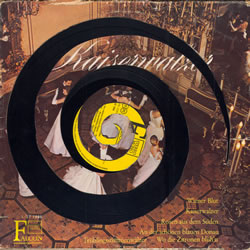
The Setup and Equipment
In a concert situation, the setup used by Vinyl Terror & Horror is exclusively based on vinyl records and turntables with all the possibilities and restrictions inherent to this medium. One of the record players has a construction built around it with multiple systems and pick-up arms, which makes it possible to play up to 8 records simultaneously. The records are placed on top of each other with rolls of tape in between, used as spacers (see Video 1 from 0:25 onwards). Another two record players are expanded with extra pick-ups so that they can play the same record from several points at once. The extra pick-ups are standing free and are flexible to change between the players (Video 1 from 2:40). The last item is an old 7‑inch record player that can hold several records on the spindle at once. When it is done playing one of the records, a new one falls down into playing position. It has this feature (failure) that it never plays one record for more than a few seconds before it sets up and begins to play the next (Video 1 from 1:15).
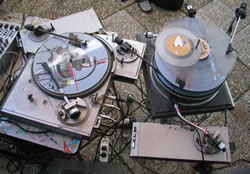
We select records with a wide variety of musical styles, a few of them being our own productions made in in a unique edition used in live performance. The other records may be commercial recordings or custom-made. Any of the records used may be left intact for standard playing, or one or more of them might be cut into pieces and reassembled (Fig. 3 and Video 1 from 4:16) or the resulting shards can be placed on an already spinning record, so the system plays the record and shard in alternation (Video 1 from 6:10). Or, the grooves of a record might be removed roughly using an engraver, making it difficult for the needle to play them “properly”. But common to all of them is that the knistery [crackling] squeaking vinyl sound is cultivated through the somewhat unpredictable “misbehaviour” of the systems and playing techniques and intentionally sloppy treatment of the equipment and records by the performers themselves.
In Performance


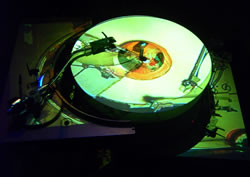
In a Vinyl Terror & Horror performance, “chance occurences” are incorporated into the performance through the prominent use of modified records. For example, with the “glass record” (parts of the vinyl are replaced by glass shards), when the needle slips out of the vinyl groove as it encounters a glass bit, the tone arm’s chaotic bouncing and scratching across the surface creates an ever-changing sound texture (Fig. 3). Underneath the record is a second tone arm that simultaneously plays the “B‑side” of the record. The audio signals are sent on separate lines to the mixer, allowing for individual control in the mix.
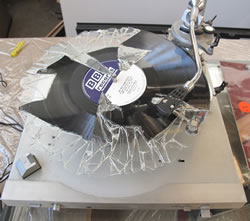
A flat spiral record (Fig. 1 and Video 1 starting at 0:00) creates a loop that varies each time the needle slides across the intertwined vinyl and Kaiserwaltzer record cover, while another spiral record is raised partly so the tone arm rides up the vinyl “hill” and falls off the edge (where the record was cut) back onto the lower part of the record in a continuous loop (Fig. 4).
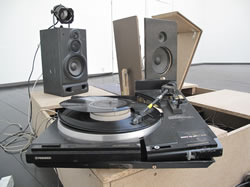


The sets are improvised with a few fixed points and include a lot of sound effects that are either sampled from movies or taken from sound effect records that refer to a specific situation, like the opening of a door, etc.
The convergence of these sounds, materials and performance techniques builds up an unpredictable narrative which is mixed with a disastrous paranormal picturesque horror soundscape that includes all the sounds that you might under other conditions prefer to avoid hearing from your record player.
Worst Case Scenario
This installation is composed for a door, a staircase of speakers, a telephone, a spiral record and a falling speaker. There is a clear visual connection between the sounds and where and how the sounds are played. The sculptures visually support the sounds but they do not attempt to be a trustworthy scenery to the very dramatic soundtrack. Their æsthetics are stripped down to the basic and they are in deep contrast to the frightening sounds of horror and the emotional atmosphere. There is a contradiction between fiction and reality. Like, for instance, when the door is silently opened by an electrical door opener while a squeaking sound is played from a speaker hanging on the door. Or, when the composition culminates with the sound of an airplane crashing playing from a speaker while falling from its cabinet towards the floor, but instead of smashing on the floor — like the sound would suggest — it lands softly on a pillow, whereafter it is later pulled back up into place.
Social top